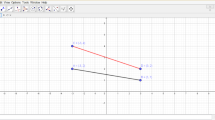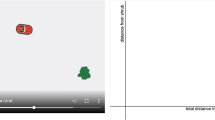Abstract
This article analyses students’ thinking as they interacted with a dynamic geometric sketch designed to explore eigenvectors and eigenvalues. We draw on the theory of instrumental genesis and, in particular, attend to the different dragging modalities used by the students throughout their explorations. Given the kinaesthetic and dynamic features of the environment, we also draw on theories of embodied cognition to analyse students’ emergent visual and kinaesthetic understandings. Our analysis suggests that, in contrast with the predominantly analytic-arithmetic mode of thinking (and the consequent procedural knowledge) reported in the literature, our students developed a synthetic-geometric mode of thinking, which researchers have pointed to as being essential to the understanding of linear algebra, but absent for most students. We also found that their synthetic-geometry mode of thinking strongly featured motion-based conceptions of eigenvectors and eigenvalues, thus leading us to characterise their thinking as dynamic-synthetic-geometric.






Similar content being viewed by others
Explore related subjects
Discover the latest articles, news and stories from top researchers in related subjects.Notes
In this study, our focus is on real eigenvectors associated with real eigenvalues.
References
Alves Dias, M., & Artigue, M. (1995). Articulation problems between different systems of symbolic representations in linear algebra. Proceedings of the 19th annual meeting of the international group for the psychology of mathematics education (Vol. 3, no. 2, pp. 34–41). Brazil: Universidade Federal de Pernambuco.
Arzarello, F., Ferrara, F., Paola, D., Robutti, O., & Sabena, C. (2005). Shaping a multi-dimensional analysis of signs. Research Forum in H. L. Chick & J. L. Vincent (Eds.), Proceedings of the 29th conference of the international group for the psychology of mathematics education (Vol. 1, pp. 126–130).
Arzarello, F., Olivero, F., Paola, D., & Robutti, O. (2002). A cognitive analysis of dragging practises in Cabri environment. ZDM, 34(3), 66–72.
Châtelet, J. (2000). Figuring space: Philosophy, mathematics and physics. Translated by Robert Shore and Muriel Zagha. Dordrecht, Boston: Kluwer.
Edwards, L., Radford, L., & Arzarello, F. (2009). Gestures and multimodality in the construction of mathematical meaning [Special Issue]. Educational Studies in Mathematics, 70(2), 175–189.
Hillel, J., & Sierpinska, A. (1994). On one persistent mistake in linear algebra. Proceedings of the 18th conference on psychology of mathematics education (pp. 65–72). Portugal: University of Lisbon.
Jackiw, N. (1989). The geometer’s sketchpad. Berkeley, CA: Key Curriculum Press.
Lay, D. C. (2006). Linear Algebra and Its Applications (3rd ed.). USA: Addison-Wesley publisher.
Núñez, R. (2006). Do real numbers really move? Language, thought, and gesture: The embodied cognitive foundations of mathematics. Reprinted in R. Hersh (Ed.), 18 Unconventional Essays on the Nature of Mathematics (pp. 160–181). New York: Springer.
Presmeg, N. C. (1986). Visualization in high school mathematics. For the learning of Mathematics, 6(3), 42–46.
Radford, L. (2009). Why do gestures matter? Sensuous cognition and the palpability of mathematical meanings. Educational Studies in Mathematics, 70(2), 111–126.
Seitz, J. A. (2000). The bodily basis of thought. New Ideas in Psychology: An International Journal of Innovative Theory in Psychology, 18(1), 23–40.
Sheets-Johnston, M. (2009). Animation: the fundamental, essential, and properly descriptive concept. Continental Philosophy Review, 42, 375–400.
Sierpinska, A. (2000). On some aspects of students’ thinking in linear algebra. In J. Dorier (Ed.), On the teaching of linear algebra (pp. 209–246). Netherlands: Kluwer Academic publishers.
Sierpinska, A., Deyfus, T., & Hillel, J. (1999). Evaluation of a teaching design in linear algebra: the case of linear transformations. Recherches en Didactique des Mathematique, 19(1), 7–41.
Sinclair, N., & Gol Tabaghi, S. (2010). Drawing space: mathematicians’ kinetic conceptions of eigenvectors. Educational Studies in Mathematics, 74(3), 223–240.
Stewart, S. (2008). Understanding linear algebra concepts through the embodied symbolic and formal worlds of mathematical thinking. Doctoral thesis: Auckland University. Available from http://hdl.handle.net/2292/2912.
Thurston, W. P. (1994). On proof and progress in mathematics. The American Mathematical Society, 30(2), 161–177.
Trouche, L. (2005). An instrumental approach to mathematics learning in symbolic calculators environments. In D. Guin, K. Ruthven, & L. Trouche (Eds.), The didactical challenge of symbolic calculators (pp. 137–163). New York: Springer.
Verillon, P., & Rabardel, P. (1995). Cognition and artifacts: a contribution to the study of thought in relation to instrumented activity. European Journal of Psychology of Education, 9(3), 77–101.
Author information
Authors and Affiliations
Corresponding author
Rights and permissions
About this article
Cite this article
Gol Tabaghi, S., Sinclair, N. Using Dynamic Geometry Software to Explore Eigenvectors: The Emergence of Dynamic-Synthetic-Geometric Thinking. Tech Know Learn 18, 149–164 (2013). https://doi.org/10.1007/s10758-013-9206-0
Published:
Issue Date:
DOI: https://doi.org/10.1007/s10758-013-9206-0




